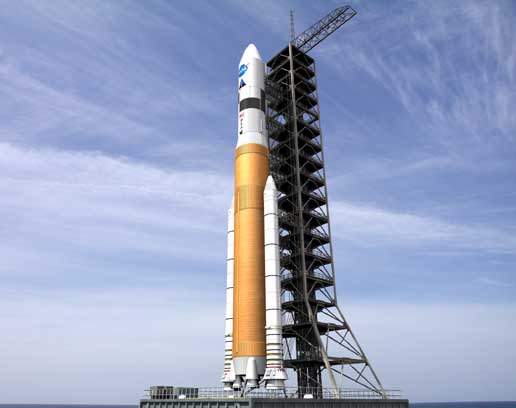
The Saturn V weighed 6.7 million lbs (3.04 million kg). The most the NASA crawler and its gravel road has ever carried is ~17 million lbs (7.7 million kg - the shuttle) and Ares V may weigh >24 million lbs (10.9 million kg). It's one huge MF'ing rocket 50 feet taller than the Saturn V (latest revision: >410 ft/125 m) and several times more powerful; six RS-68 main engines + two 5.5 segment SRB's on the first stage (the shuttle uses 4 segment SRB's).
FlightGlobal.com.....
NASA faces budget busting crawlerway rebuild for Ares V
NASA's Kennedy Space Center crawlerway may have to be rebuilt because the combined weight of the agency's Ares V cargo launch vehicle, its mobile launcher and crawler-transporter for the Constellation programme look like being too heavy for it.
Built 40 years ago for the Apollo programme, the crawlerway is the road over which crawler-transporters carry the Space Shuttle. It will carry the Ares I crew launch vehicle and the cargo launch vehicle from the vehicle assembly building to Kennedy's launch complex pads A and B the furthest, B, is 6.8km (4.2 miles) from the assembly building.
The crawlerway consists of two 12m (40ft)-wide lanes, separated 15m apart. The surface, at its thickest points on the curves, has 200mm (8in) of river gravel that is on top of 900mm of compacted limerock, which is in turn on top of two layers of "select fill" that is up to 1.1m deep in total.
The crawler-transporter, mobile launcher and Space Shuttle, with empty external tank, has a mass of about 7.7 million kg (16.9 million lb). Ares V could weigh as much as 10.9 million kg.
"Given the projected weight of the Ares V vehicle, mobile launcher and transporter, the total weight is about 33% higher than the crawlerway has ever supported there is a possibility that the crawlerway could fail to support the load, resulting in severe impacts to the Constellation programme," says a Constellation vertical integration element risk assessment.
NASA was unavailable for comment, but in July its administrator Michael Griffin spoke of the budget difficulties that changing infrastructure would create for Constellation, saying: "We don't have a budget sufficient to tear down all our buildings and build new ones to fit a new architecture."
NASA's crawlerway mitigation plan is to collate data and analysis to establish "confidence levels" on the effects of loading it beyond 8.1 million kg and perform loading tests.
NASA's Kennedy Space Center crawlerway may have to be rebuilt because the combined weight of the agency's Ares V cargo launch vehicle, its mobile launcher and crawler-transporter for the Constellation programme look like being too heavy for it.
Built 40 years ago for the Apollo programme, the crawlerway is the road over which crawler-transporters carry the Space Shuttle. It will carry the Ares I crew launch vehicle and the cargo launch vehicle from the vehicle assembly building to Kennedy's launch complex pads A and B the furthest, B, is 6.8km (4.2 miles) from the assembly building.
The crawlerway consists of two 12m (40ft)-wide lanes, separated 15m apart. The surface, at its thickest points on the curves, has 200mm (8in) of river gravel that is on top of 900mm of compacted limerock, which is in turn on top of two layers of "select fill" that is up to 1.1m deep in total.
The crawler-transporter, mobile launcher and Space Shuttle, with empty external tank, has a mass of about 7.7 million kg (16.9 million lb). Ares V could weigh as much as 10.9 million kg.
"Given the projected weight of the Ares V vehicle, mobile launcher and transporter, the total weight is about 33% higher than the crawlerway has ever supported there is a possibility that the crawlerway could fail to support the load, resulting in severe impacts to the Constellation programme," says a Constellation vertical integration element risk assessment.
NASA was unavailable for comment, but in July its administrator Michael Griffin spoke of the budget difficulties that changing infrastructure would create for Constellation, saying: "We don't have a budget sufficient to tear down all our buildings and build new ones to fit a new architecture."
NASA's crawlerway mitigation plan is to collate data and analysis to establish "confidence levels" on the effects of loading it beyond 8.1 million kg and perform loading tests.

Comment